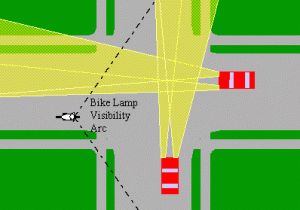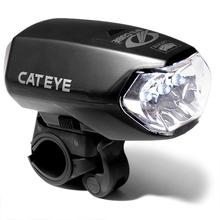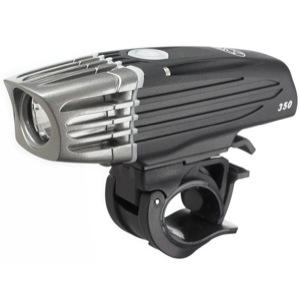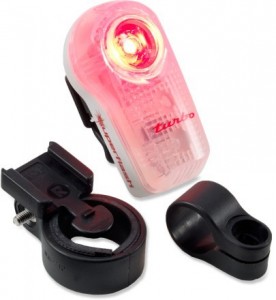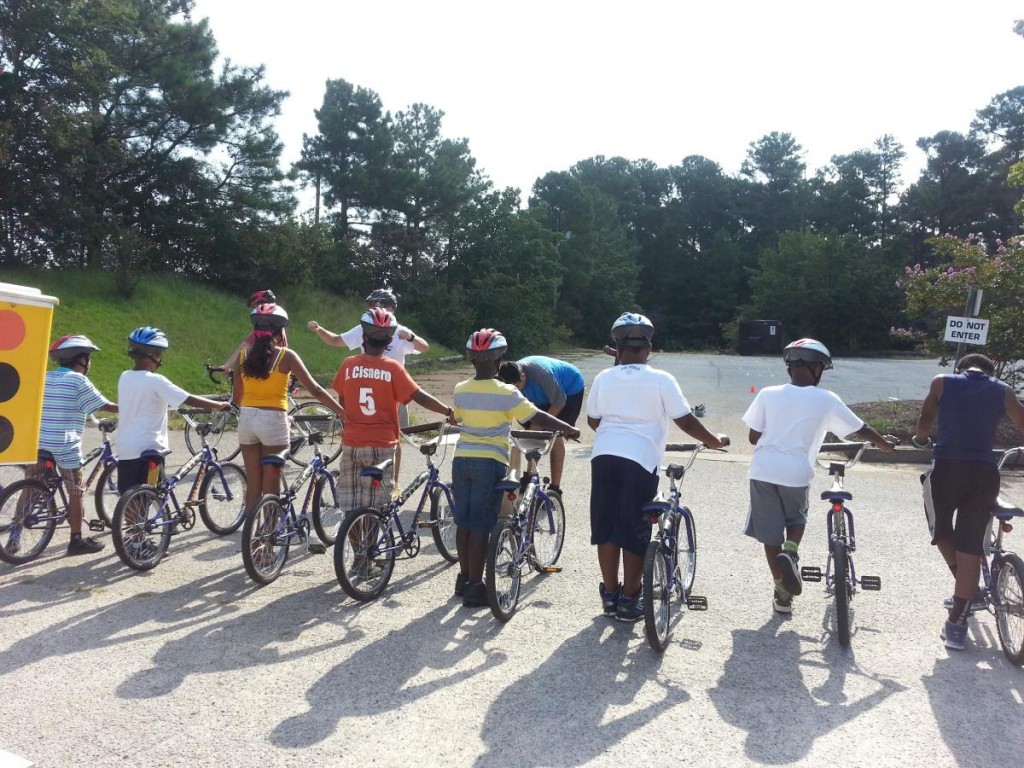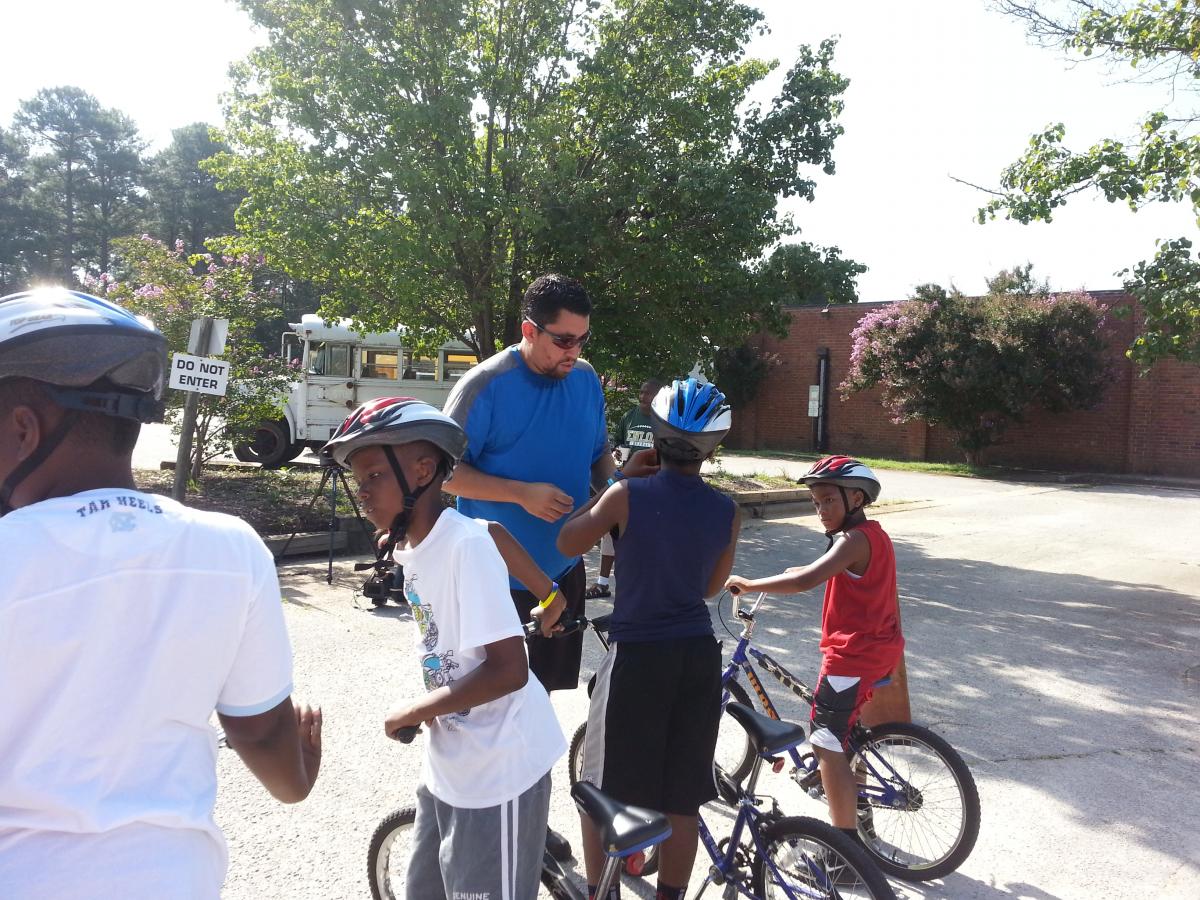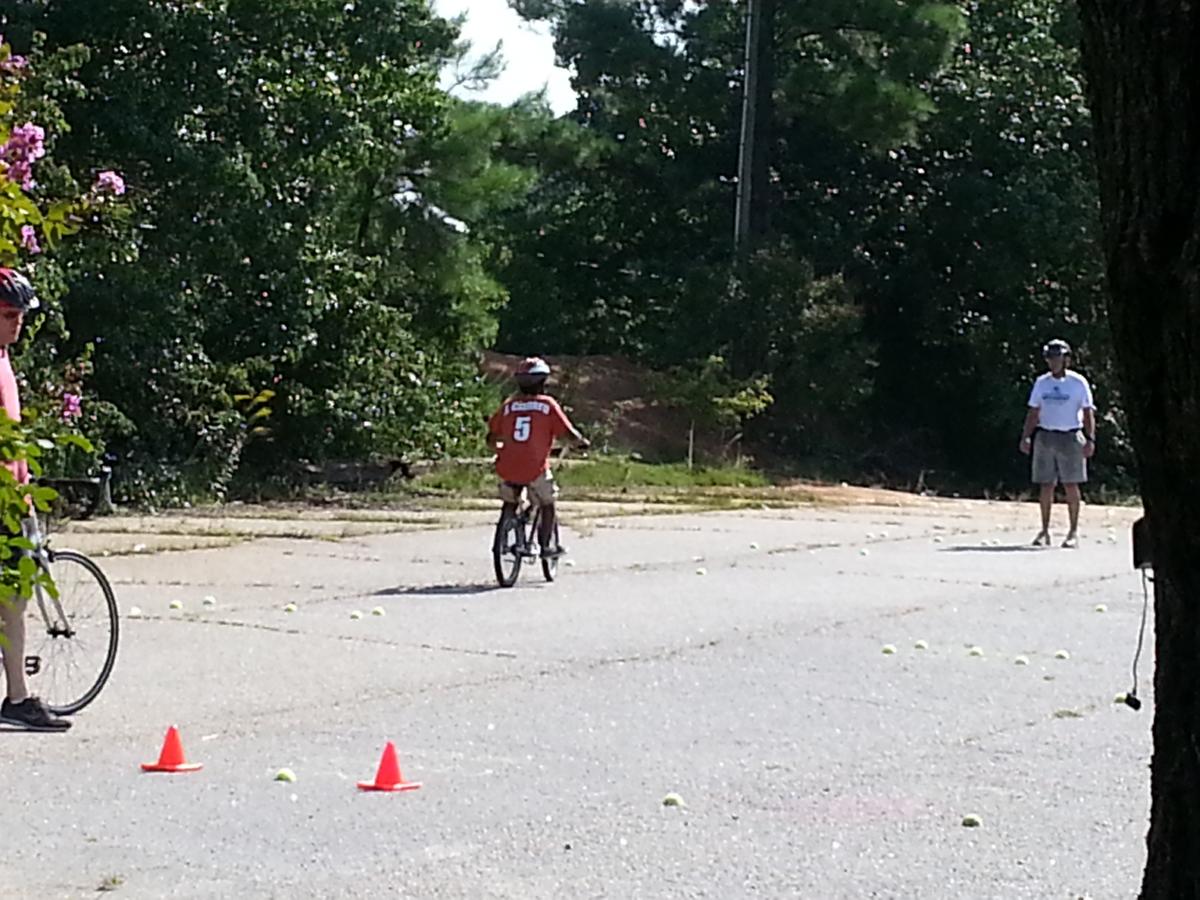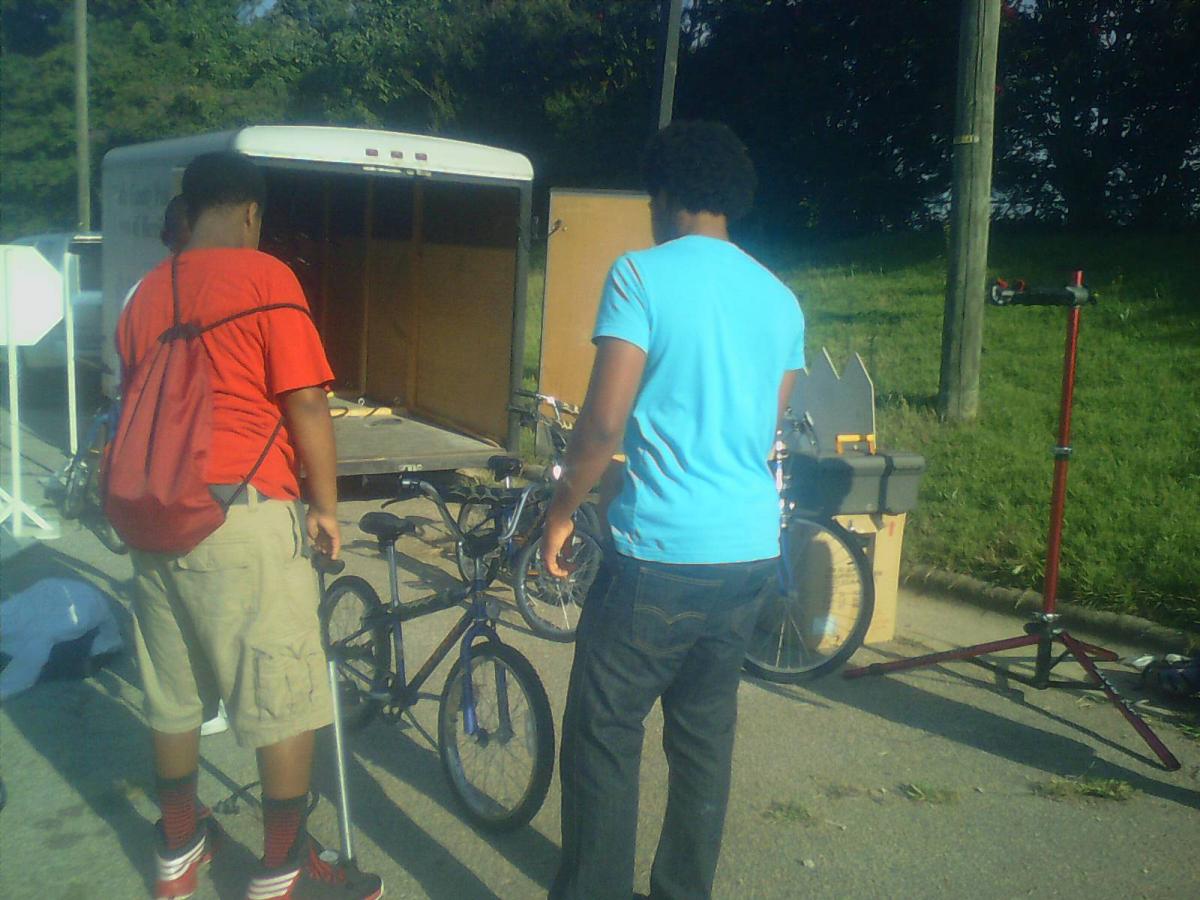For good reason, North Carolina state law (§ 20-129.e) requires bicycles operated at night to be equipped with a white headlamp in front and rear reflector plus red lamp or reflective garment in back. Never ride at night without a headlamp and a rear lamp. Although most bicycles are sold with small “toy” reflectors, these are terribly inadequate for safe night cycling. The car-bike collision rate is several times higher at night than during daylight, but the vast majority of these crashes involve cyclists operating without proper nighttime equipment and can be easily prevented. Proper equipment makes cyclists visible to other road users and can make cycling at night much safer than statistics suggest that it is.
Proper bicycle lighting is important for two reasons:
- It makes you visible and predictable to other road users
- It can help you see well enough to avoid hazards and navigate your way
Being Visible and Predictable
Many cyclists ride in urban environments where they feel that they can see well enough to navigate, so they don’t bother with headlamps. This can be very dangerous, because without a headlamp other drivers often do not see them, even under street lamps. Reflectors can provide good visibility for overtaking traffic under some circumstances, but most dangers of car-bike collisions come from the front or side of the cyclist. The headlamp beams of vehicles on intersecting paths with cyclists often do not shine upon the reflectors of a bicycle until it is too late for the motorist to yield right of way or avoid collision. The figure below shows the positions of two vehicles that might be about to drive out or turn across the cyclist’s path
Vehicle headlamps often do not illuminate the cyclist’s reflectors, creating a danger at intersections.
The photos below show the difference in visibility of a cyclist with and without a front headlamp.
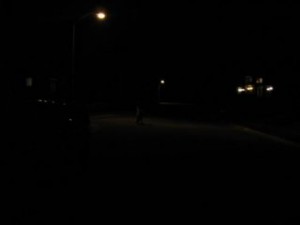
An approaching cyclist in the roadway under a street lamp, with no front light.
A cyclist approaching in the same position as above, this time with a headlamp on the bicycle plus a helmet lamp.
Bicycle headlamps should emit a steady white (or nearly white) light because this indicates the direction that the vehicle is traveling. Most vehicles, including aircraft and boats, exploit a color convention to indicate orientation or direction of travel. For road vehicles, red lights belong in back, amber lights on the side, and white lights in front. The fact that reverse-gear lights of a motor vehicle are white provides an important cue as to what the motorist is about to do. It’s important for cyclists to comply with this convention in order for other road users to predict their actions. For instance, using a red lamp on the front of a bicycle is likely to cause opposite-direction divers to underestimate the closing speed between vehicles because they will expect the red-lighted object to be either stationary or moving in the same direction.
A red rear lamp or reflector makes a bicycle visible to overtaking traffic. It’s important to make this reflector or lamp large enough and bright enough to be seen by motorists at enough distance to slow or stop in time when traveling at high speeds. Color is generally less important on the rear of the vehicle, since overtaking motorists will not be any less cautious when viewing another color, but red is the convention and is a universally understood warning indicator. A variety of red LED (Light Emitting Diode) tail lamps available for bicycles; these lamps are visible at longer distances and a wider angles than are most reflectors, and don’t depend on vehicle headlights to be effective.
Note that side reflectors don’t hurt, but they are rarely of much use because if a vehicle’s headlamps are shining on them, you will either be riding ahead and out of the way before the vehicle arrives or it is already too late for the driver to avoid you. Pedal reflectors are more useful; some drivers report that pedal reflectors are even more conspicuous than tail lamps when approaching a bicyclist from behind. Reflective dots on shoe heels are an alternative for clipless pedal users.
Seeing What’s Ahead
The amount of light your headlamp needs to shine on the roadway in order to see your way depends on where and how fast you ride. A cyclist riding at high speed on a dark rural road needs a long, relatively narrow beam of light to see surface conditions and obstacles far enough ahead. A mountain biker riding over challenging off-road terrain needs a wide, bright beam to find suitable paths over obstacles and around turns. By contrast, an urban cyclist operating under street lamps may require just enough beam strength to allow navigation of the occasional dark stretch at reduced speed.
The faster you ride, the longer your effective headlamp beam needs to be; if you double your speed, you need to see twice as far. Note that since the perceived power of reflected light decreases in proportion to the square of distance from the lamp, doubling the range for a given reflection power requires four times as much light power from the lamp. The light provided by a bicycle headlamp may be focused into a narrow beam for maximum range, or may be spread out for better peripheral vision. A low powered lamp can be focused into a beam suitable for high speed cycling on the darkest roads, but such a pattern will not give much illumination of turns. Any headlamp, even the cheapest clip-on battery kind, is much safer than none at all – you just need to ride slower to compensate for reduced range.
On totally dark roads, our eyes adapt to the darkness and allow us to see surprisingly well with a low-power headlamp. However, street lamps and the headlamps of oncoming cars can inhibit or reverse the adaptation of our eyes. This makes cycling on partially-lit roads or with oncoming traffic on rural roads more challenging with low-power headlamps. It’s a good idea to use the most powerful headlamp available for your cycling needs and your price range.
Special Hazards to See
Remember that motor vehicle traffic isn’t the only hazard at night. Don’t be surprised to find animals, unlit pedestrians dressed in black, and unlit wrong-way cyclists in your path at night. Look for them carefully, and give them wide berth when you see them. Also remember that it’s harder to see potholes and gravel. Also, wet road surfaces do not reflect as much light as dry roads, making driving lights (head and frame mounted white lights) less effective.
Increased Hazards from Motorists
On average, the percentage of highway users who are impaired by fatigue, poor night vision and alcohol increases at night. Drunk, drowsy, and severely distracted drivers are the greatest threat to lawfully operating cyclists at any time of day. Fortunately, the total number of motorists on the roads usually decreases at night. Many experienced night cyclists who use proper lighting report that overtaking motorists give them wider berth after dark. With reduced traffic and strong lights, it is arguable that the properly equipped night cyclist may actually be more visible and easier for motorists to avoid than the daytime cyclist.
Riding into the Sun
One situation which cannot be helped much by night equipment is poor cyclist visibility when riding directly into sunrise or sunset. Motorists are often blinded to the point that they can barely see more than the outlines of motor vehicles ahead of them. Under such conditions, the law requires drivers to slow down to a speed at which they will be able to respond safely, yet in too many cases they continue to drive at full speed. If possible, a cyclist may wait for the sun to set (you have your lights, right?) or to rise higher before riding. If you do ride into the sun, leave drivers a longer buffer of response time and distance when entering the lane in front of them.
Choosing the Right Equipment
Headlamps
A variety of bicycle headlamps are available depending on the user’s preference for range, light output, mounting style, and cost. Helmet mounted lights put the light where you’re looking. Bike mounted lights put the light near where your bike is going to be very soon. For maximum effectiveness, you can use both. Note that it’s also good to have a back-up light source or spare batteries.
The cheapest, shortest-range lights suitable for emergencies or occasional urban use are low-wattage clip-on lamps powered by disposable batteries stored inside the lamp housing. These lamps can get you home safely when you’re out after dark, and are good as a back-up, but most don’t have enough light output for high speed cycling on dark roads, they usually have limited range, and most of them eat batteries. Recent advancements in LED-based headlamps have greatly improved the range and light power of inexpensive battery-powered clip-on lamps.
LED headlamps powered by AA batteries are now available in a variety of light powers and run times.
Rechargeable battery-powered lighting systems provide the highest light output (starting at around 250 lumens; most good ones are now well above 400 lumens), making them especially popular for mountain biking, and can offer operating times of over two hours between charges. Some even have fuel gauges and multiple power settings so you can control your range. The high power availability allows wide beam width which also maximizes visibility to other road users. Recent advances in battery and lamp technology provide increased power efficiency, lower battery weight, and easier charging, than previous battery-powered headlamp systems. However, these lamp systems usually cost over $50, often well over $100.
This NiteRider LED headlamp with an internal Li-Ion rechargeable battery provides higher light lumens than disposable-battery lamps.
For unlimited range without the worry of battery maintenance, generators are the ideal choice. Many randonneurs swear by them, since their rides can exceed the operating time of a single battery lamp. Generators may be built into the front hub or attach to the tire. Early-generation generators would not provide any light with the bicycle stopped, would glow dimly at low speed, and could potentially burn out the lamp at high speed. Some modern generator systems use smart electronics to regulate power production such that the lamp is bright even at slow cycling speeds, and ensure there is no danger of burnout at high speeds. Some are even combined with power storage to provide illumination when stopped; the power storage recharges while the cyclist is moving. Generator powered lights reduce your speed capability somewhat because of the extra drag, which may be 10% of your pedaling effort. The most attractive and convenient generators, such as the Shimano DH-3N70 and the Schmidt Dyno Hub, are built into the front wheel hub. Bottle generators, such as the Dynosys LightSpin, rub against the tire.
Front strobes or flashers may also add to the cyclist’s conspicuity. However, these should not be used as a substitute for a normal headlamp.
Rear Reflectors
At close distance, when conditions are right, reflectors can be as visible as rear lamps – but conditions are not always right. Bicycle and automotive reflectors use the cube-corner reflection principle to reflect light back along the same path from which it came. This means that the observer’s eye must be very close to the light source – less than a two degree arc, in fact – to see a strong reflection. If the driver’s side headlamp is not turned on or working, the reflector may not be visible to the driver. The reflector must also be close to perpendicular to the observation angle.
Most bicycles come with small toy reflectors required by the Consumer Products Safety Commission (CPSC). These reflectors are too small to provide adequate visibility under many realistic road conditions, such as high-speed thoroughfares. A typical CPSC reflector provides only 1.7 square inches of directly exposed surface area and 1 square inch of surface angled to one side under optimum viewing conditions. The cyclist is better off replacing this rear reflector with a larger one from an automotive store. A 3? diameter round automotive reflector provides 7 square inches of reflector area. An oblong “trailer” reflector provides six square inches.
Note that an amber reflector is 2.5 times as bright as a red reflector under the same headlight illumination. By law, a red reflector is required, but adding an amber reflector to the red one is a good idea. With this combination, you’ll be over ten times brighter than with just one toy CPSC reflector.
Reflectors are very sensitive to mounting location and orientation. Reflectors on the frame should be mounted low to reflect the lights of other vehicles sooner. The face of the reflector should be perpendicular to the ground. If the rear reflector is where it may be sprayed by mud from the tire, clean it often.
Tail Lamps
Inexpensive tail lamps, typically employing red, energy-efficient light emitting diodes (LEDs), don’t rely on a motorist’s headlamps to be visible, are visible from farther away, and can be seen clearly from the side as well.
The Planet Bike Superflash Turbo is a 1 Watt LED tail lamp that is daylight visible and will get you noticed at night from a mile away.
These lamps will last many hours on a pair of disposable batteries. However, they often glow dimly long before they fail; it’s important to inspect them before each ride and change the batteries regularly. Above all, use a reflector in addition to the tail lamp so you have a backup. Note that many of the clamp-on mounts for tail lamps and reflectors are easily knocked out of alignment. Be sure to inspect them often, and consider using more than one retro-reflective device on separate mounts in case one gets misaligned without you noticing it. (Once, after hitting a pothole, the author discovered that the shock had caused the cover of his VistaLite tail lamp to pop off and dump its batteries with it. Were it not for a secondary reflector, the bicycle would have had no rear-facing visibility equipment for the remainder of the trip. A band of electrical tape around the perimeter of the lens can keep this from happening and also seal out water.)
Steady versus Pulsating versus Flash
There is some controversy over whether pulsating tail lamps are better than steady tail lamps. A rapid pulse is better than a slow flash, because it is easier to track visually. (Remember the difficulty of catching fireflies between flashes?) The rapid pulse also grabs attention more readily at long distances than does a solid lamp. Proponents of steady lamps say steady lamps are just as visible at short distances, which they say is what counts, that steady lamps are potentially less annoying or distracting, and that there is little use in looking different from other traffic. Proponents of flashing lamps believe that it is useful to alert motorists to the presence of a special road user (a bicyclist) farther ahead so the motorist can better prepare in advance to overtake with caution. Also, flashing lamps use much less average power to achieve the same maximum instantaneous brightness.
Reflective Clothing
Lights are essential for visibility under all conditions. However, retro-reflective clothing may help approaching drivers estimate your size and distance more easily and accurately than can just a single lamp or reflector. Ankle or pedal reflectors move and attract attention. Reflective material on a jacket or glove also help you convey hand signals at night. Remember that retro-reflective clothing supplements, but never replaces, good lights and bike-mounted reflectors.
